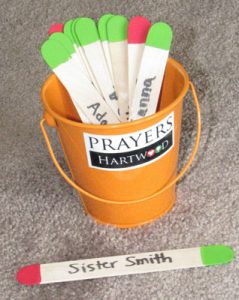
Use this tool to solve common problems you'll find in your gospel classroom. Select from the options below to find teaching techniques that will help you solve some of the most common problems in LDS gospel classrooms:
A student suggested this method based on something they do in her drama class at school. A narrator reads a passage of scripture while students act out their roles. Someone (a teacher or another person) randomly chooses a character to "vote off the island". This selection can be done by tapping an actor on the shoulder or dubbing them with a foam sword or other item. Now, the remaining characters continue to act out their roles, but they must also stand in for the missing actor. Eventually only one actor is left and he or she must play all of the roles.
Here's an example with Adam and Eve and the snake and the tree. Actors fill all four roles while the narrator reads the story. One of the four is removed (say the snake). Now the three actors play the four roles. Another actor is removed. Now two actors play four roles. Eventually only one actor is left and he or she must play all four roles.
When using Scripture Survivor, be sure that the length of the passage corresponds with the number of actors. For example, a passage with many characters would need to be long for this to work best, and a short passage would need to have a fewer characters.
This could be used in a group of laid back adults as an attention-getter. If your class is uptight, skip this one.
If you're teaching youth, you know that on occasion, students will ask disruptive or off-topic questions. I am always trying to encourage my students to ask questions, and I am always worried that shooting down a question too hard will frighten off others who have questions. I have made the mistake before of shooting down a question that I felt was off topic only to realize later it was a genuine question. I felt horrible.
Now when I am asked a question that is a little off, I say, "Ok, let's talk about that. What do you all think?" and I redirect the question to the other students in the class. Suddenly, peers are put in the position of experts, and they respond accordingly. If the student was trying to throw me off, they don't get what they wanted (a flustered teacher), and suddenly their peers are telling them why their question was ill-formed, or they are answering the question like it is valuable. I have found that this peer redirection shuts most question-related problems down almost instantly. If it was actually a serious question, no one's feeling are hurt, because the question has been treated respectfully, and other students had the chance to respond.
I have found that responding to all questions as if they were fantastic, well-though out questions has really improved the culture of my classroom. It is more important to me that I create a classroom culture where all questions are safe to ask than risk alienating or hurting a student by mistaking a serious question for something intended to disrupt class.
Students open their notebooks and write two things: one question they had about the reading and one thing they learned anew or that they had forgotten. We spent probably 40 minutes covering the things they wrote. Great discussion and opportunity for sharing.
I learned this method at a Seminary regional training. It's a great method that requires little or no preparation. This works best with passages that include plenty of action.
Assign one student to be the narrator. The Narrator will read a passage of scripture with FEELING. He or she should do the voices and any sound effects needed for the roles. Other students are assigned to be the actors in the Kung Fu movie. These actors will dramatize and lip sync their roles, but they don't speak. The effect looks like bad dubbing in a kung fu movie. This is an easy way to engage students in the scriptures. Even those not acting or narrating are engaged because it's just so funny!
This one is fun for adult classes, too, as long as the group is laid back.
I learned this technique from Deann, who learned it from The Famous Linda D:
When you have a large class of youth, you will need a seating chart to help behavior issues. It's not mean -- it's positioning everyone so they can participate constructively. Daniel Roma teaches Seminary teachers that f you have more than five students, you need a seating chart.
Deann seats her students boy/girl/boy/girl. I have never done that, but I do require students to sit with their zone, which I rotate.
Assign students into Zones, or groups, of 3-5 students. This is a team that will compete in games together and participate in other activities as a group. One student is the zone leader. I use the zone leaders to represent the zone when selecting activities, they lead group discussions, they present for the group when we do a group presentation, or he or she may be the "nonmember" when playing Member/Nonmember. When giving instructions, Linda D says, "Zone leaders, give me a wink and a nod when you know what I'm talking about and can lead your zone." She also says, "Classroom management is about getting kids from being strangers to being a team." Splitting into zones is a good way to help that effort.
Linda names her zones cleverly: Cal-zone, End-zone, O-zone, etc. I just have numbered zones, or I call them by their leader's name: Emily's zone or Jake's zone.
I have found that zones make it much easier to keep students who talk too much apart. It also helps students get to know others in the classroom, and it gives leadership opportunities to shy youth. I also don't have to spend time on the logistics of separating into groups for group work, because students know to work within their zones.
I used these questions on a worksheet to help students evaluate and understand personalities in the scriptures:
Name:
Scripture:
Spouse/Children:
Age:
Hometown:
Occupation:
Describe this person using only three words. Circle the word you feel is this person's core quality:
________________ , ________________ , ________________
Briefly describe the person's attitude toward:
Him/Herself _______________________________________________
Family ____________________________________________________
God ______________________________________________________
What problem(s) has this person experienced?
Describe an event from the life of this person that is meaningful to you:
How does/might this person react when under temptation or stress?
How did/might this person solve their problem?
What did Heavenly Father/Jesus do to/for this person?
Wise people learn from their own choices; super-wise people learn from the choices of others. What can you learn from this person's choices (good or bad)?
Write the assigned verses or passages on a post it note. Mix up the order you will be covering the passages in, and stick an assignment under each seat in the classroom. When it comes time to read, have everyone look under their seat for their passage and read.
I usually employ this method when we have several scriptures to read from different areas of the scriptures.
When using this method -- especially with adults -- be sure that everyone in your class can read before class begins. If you know some members of the class are not thrilled with reading aloud, remind the class that it's okay to mispronounce words or read slowly. I do it, too, and Church is a judgment-free zone.
For many teachers, there is an imaginary line about 5 feet in front of the chalkboard, near the table. Students do not cross that line, nor do teachers. One of the best Classroom management skills you can develop is breaking The Plane, or getting in the habit of moving about the classroom as you teach.
There's a great discussion of this in the book Teach Like a Champion by Doug Lemov. It's Technique 15 "Circulate". He suggests that teachers cross that imaginary line during the first five minutes of every class. He suggests that teachers must suggest to their students that they own the room, and it's normal for the teacher to move around anywhere in the classroom. I have found this to be very helpful in my class. You already know that approaching a chatting student can help redirect them. You may need to tap them on the shoulder and point where they should be looking, or you might bend down and talk. Practice moving around the room as you teach so that students become comfortable with the idea of you moving around. It will help you address problems quickly and with minimal disruption.
I have been trying to learn this technique myself. It is HARD to cross that line for the first few times -- it's like a force field! But now, my students don't think twice about me moving in and among their tables or looking over their shoulders, listening in on a group discussion, or answering a private question. What's more, it's much easier for me to move toward a student and cut off their talking without breaking the discussion or causing a big disruption. Most of the class isn't even aware of me stopping a situation before it gets out of hand, because they are already accustomed to me moving around.
Have each student read a scripture on a gospel topic or a keyword written on a wordstrip and then place that wordstrip under the correct header.
EXAMPLE: I used this method to teach the plan of salvation. I divided the board into three sections: premortal, mortal, and postmortal. I also stuck Post-it notes with words like fall, creation, resurrection, birth, war in heaven, outer darkness, death, celestial glory, paradise, spirit prison, etc, underneath each of the chairs in the room. My Lesson opener was to introduce the material and then have the kids look under their seats to get their post it and stick it on the board in the correct section. Then as a group we would correct any mistakes, and we would go over each of the topics that needed explanation.
You know how this works: each student's name is written on a piece of paper. You draw a name out and that's the person who reads or prays next.
EXAMPLE: I use a bucket with craft sticks that have each student's name written on it. One end of the stick is red and the other is green. Students with red facing up, have been chosen. It's an easy way to remember who has already had a turn without having to keep track of a list. Students like that they can see they aren't being "picked on". I use it for randomly assigning prayers and keeping track of who has given prayers already. I have also used the bucket to draw names for scripture reading or sharing ideas as well.
It's easiest to use this method when a classroom's attendees don't change too much from week to week. But if you're using it in adult Sunday School or Elder's Quorum, you could have students write their names down on a list at the beginning of class, have a volunteer cut it apart, and then draw the names from the hat.
